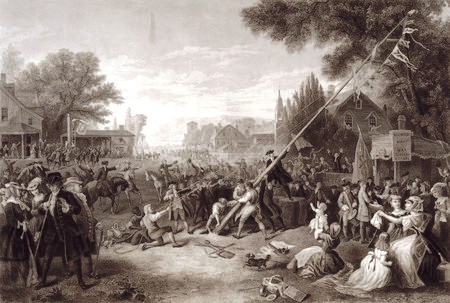Before I get to my specifically legal argument about symbolic expression and the original meaning of the First Amendment, I wanted to say a bit about the kinds of symbolic expression that were commonplace in England and especially America of that time. Of course, the common nature of such symbolic expression doesn't by itself prove that such expression is constitutionally protected; but it helps show why the evidence that I have come up with makes sense in light of the Framing era's actual practice of using symbolic expression interchangeably with words. Plus some of the items are quite a bit of fun.
To begin with, one of the leading English holidays, Guy Fawkes Day (called Pope Day in the colonies), revolved around processions and burning effigies. John Jay, the coauthor of The Federalist, Supreme Court Chief Justice, and negotiator of a much-opposed treaty with England, "wryly observed that he could have found his way across the country by the light of his burning effigies in which he was represented selling his country for British gold" -- a continuation of the pre-Revolutionary pattern of burning the effigies of disliked colonial governors.
And sometimes the effigies became parts of more elaborate, and at times self-consciously humorous, displays. In the first major protest against the Stamp Act, colonists placed on a "Liberty Tree" (in that case, a large elm) various effigies, including a "devil . . . peep[ing] out of a boot -- a pun on the name of former British Prime Minister Lord Bute (pronounced Boot), who was widely if erroneously believed to be responsible for the Stamp Act"; "[t]he effigies were then paraded around town, beheaded, and burned."
Puns were commonplace in other contexts as well. For instance, English supporters of restoring the Stuarts would pass a wine glass over a water jug while drinking a toast to the health of the king, as a clandestine symbol that one is toasting the "King over the Water," which is to say the Pretender, who lived in exile in France.
Numbers often played a role in symbolic displays. Englishmen and Americans who sympathized with English radical and colonial hero John Wilkes not only toasted him, but toasted and celebrated him using a number associated with him: Forty-five toasts -- representing issue 45 of Wilkes' North Briton, which got him prosecuted for seditious libel and made him a star -- were drunk at political dinners where forty-five diners ate forty-five pounds of beef; at other dinners, the meal was "eaten from plates marked 'No. 45'"; the Liberty Tree in Boston had its branches "thinned out so as to number forty-five." Note also that here, as well as in some of the other examples, literal speech (the words of the toasts) was freely mixed with symbolic expression.
 |
I haven't seen the Framers wearing symbolic armbands, but their equivalent were cockades worn in hats. Thus, for instance, many 1790s Americans wore colored cockades to represent their Republican (red, white, and blue, referring to Republican sympathy for the French Revolution) or Federalist (black) allegiances. Some wore cockades made of cow dung as a mockery of the other side's cockades. Some conducted mock funerals for the other side's cockades (see the picture above). Mock funerals occurred in other contexts as well: For instance, colonists conducted funeral processions for liberty as protests against the Stamp Act.
 |
Flags and liberty poles (see the picture above) also played a role. (Liberty poles were often described as "standards," in the sense of the equivalents of flags.) From the pre-Revolutionary era to the 1790s, Americans raised liberty poles as symbols of opposition to what they saw as oppressive conduct by the government. They burned "Liberty or Death" flags stripped from their adversaries' liberty poles. They planned elaborate pantomimes criticizing their Congressmen, with displays of the French and American flags crowned with liberty caps, an upside-down British flag, and a gallows, followed by the burning of the British flag.
And burning played a major role as well, as I've already suggested. After the Revolution, Americans burned copies of the Sedition Act and other federal laws. They burned copies of opponents' publications that they saw as libelous, echoing the English legal practice of having libels be burned by the hangman.
So it is understandable that a nation that so often used symbolic expression as part of politics would see the freedom of speech and press as covering symbolic expression to the same extent as verbal or printed expression. Likewise, it makes sense that the protection for symbolic expression on the Supreme Court dates back to the very first Supreme Court decision striking down any government action on free speech or free press grounds. The Court in that 1931 case simply casually assumed that symbolic expression was as protected as verbal expression, and treated the display of a red flag as legally tantamount to antigovernment speech. But its assumption was consistent with the First Amendment's original meaning: The equivalence of symbolic expression and verbal expression has been part of American practice -- and, as I'll try to show below, American law -- since the Framing era.
Related Posts (on one page):
- "Freedom of Speech, or of the Press" as the "Right To Speak, To Write, or To Publish," Including Symbolic Expression:
- Symbolic Expression in Late 1700s and Early 1800s Discussions of Constitutional Law:
- Symbolic Expression in Late 1700s and Early 1800s Speech Restriction Law:
- A Brief Note on Symbolic Expression During the Framing Era:
- Symbolic Expression and the Original Meaning of the First Amendment: